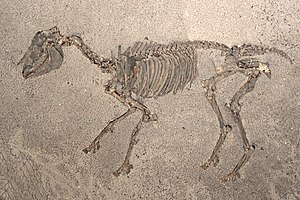Hippotherium
This article has been registered in the quality assurance biology for improvement due to formal or content-related deficiencies . This is done in order to bring the quality of the biology articles to an acceptable level. Please help improve this article! Articles that are not significantly improved can be deleted if necessary.
Read the more detailed information in the minimum requirements for biology articles .
| Hippotherium | ||||||||||||
|---|---|---|---|---|---|---|---|---|---|---|---|---|

Hipparion primigenius from the fossil site at Höwenegg , Karlsruhe Natural History Museum |
||||||||||||
| Temporal occurrence | ||||||||||||
| Miocene to Pliocene | ||||||||||||
| Locations | ||||||||||||
|
Höwenegg and others |
||||||||||||
| Systematics | ||||||||||||
|
||||||||||||
| Scientific name | ||||||||||||
| Hippotherium | ||||||||||||
| Kaup , 1833 | ||||||||||||
Hippotherium refers to an extinct genus from the Equidae familyfrom the Pliocene to the Miocene . The best known and most common species was Hipparion primigenius , which occurred in Europe, Africa and Asia. Johann Jakob Kaup described other findsas Hippotherium gracile and Hippotherium nanus . The name Hipparion comes from the description by Jules de Christol in 1832.
ancestors
Indirect ancestors or side branches formed the "primordial horses" Hallensia , Propalaeotherium and Eurohippus . The last two genera each represent several species. So far, over 70 skeletons have been discovered in the Messel Pit .
Hipparion and Hippotherium
From the animals similar to Merychippus a side branch of the Hipparionini developed , to which Hipparion and Hippotherium are counted, on the other hand, the Equini , to which today's species belong.
While the genus Merychippus was restricted to North America, the Hipparion immigrated to Eurasia about 12 million years ago over the Beringland Bridge and replaced anchitherium there . Hipparion was the first horse to reach the African continent.
The lateral toes slowly disappeared within the equini , which were developing further in North America. One of its oldest representatives was Pliohippus , who lived in North America around 15 million years ago. It already looked very similar to modern horses and was already monoed.
Hippidion followed in the Pleistocene up to modern times .
|
Internal systematics of the Equidae according to Prado and Alberdi 1996 and Mihlbachler et al. 2011
|
literature
- Jaco Weinstock et al: Evolution, Systematics and Phylogeography of Pleistocene Horses in the New World: A Molecular Perspective. In: PLoS Biology . 3, 8, 2005, e241, doi : 10.1371 / journal.pbio.0030241
- Jens Lorenz Franzen : The primeval horses of the dawn. Elsevier / Spektrum Akademischer Verlag, Munich 2007, ISBN 3-8274-1680-9 .
Web links
Individual evidence
- ↑ Ann Forstén: Hipparion Primigenium (v.Meyer 1829), to early three-toed horse In: Annales Zoologici Fennici 15 1978. Helsinki. PDF, eng.
- ↑ José L. Prado, María T. Alberdi: A cladistic analysis of the horses of the tribe Equini. In: Journal of Palaeontology. 39 (3), 1996, pp. 663-680.
- ^ Matthew C. Mihlbachler, Florent Rivals, Nikos Solounias, Gina M. Semperbon: Dietary Change and Evolution of Horses in North America. In: Science. 331, 2011, pp. 1178-1181.